July 2023
| WESSEL VAN WYK, SOYBEAN SPECIALIST AND CONTRACTOR, PROTEIN RESEARCH FOUNDATION |
 |
As there are a number of factors that must be considered and addressed before production begins, the decision to plant soybeans should be made at least two years before the first production season (actual planting).
The most important factor is to obtain soil samples of the earmarked areas, have these samples analysed and do the necessary soil corrections recommended from the samples. The pH and lime requirements are particularly important, as the lime application should be done on the crop planted before soybeans. If large corrections of phosphorus (P) and potassium (K) are required, a large part of it can also be done on the preceding crop.
A second factor to consider is the possible transmission of herbicides from one season (crop) to another season (crop). For instance, herbicides that are used in maize and wheat production can generally not be used on soybeans. There are also waiting periods before soybeans can be planted in the same soil where certain herbicides were used previously. It is advisable to withdraw herbicides that have a waiting period of ten to twelve months at least two years prior to planting soybean in the same soil.
Thirdly, all compacted layers should be broken up (ripped). It is also important to use fields that are not rocky and/or very uneven. Soybeans are harvested at a low level (30 mm to 60 mm), and the harvester blade can be damaged if lands are uneven and/or rocky.
When a farmer makes use of contract harvesting, he/she should ensure that the contract makes provision for a set harvest date. The number of days between planting and harvesting varies greatly between seed cultivars. It is therefore important to obtain this information from seed companies. Lands that are prone to waterlogging and yellow nut sedge (uintjies) should also be avoided.
SOIL
Avoid soil with structural damage, which is usually indicated by the presence of clods with sizes between a golf ball and tennis ball (Photo 1) and occurs due to heavy showers. This leads to the poor emergence of soybeans. Soil that compacts because of textural problems (clay percentage), should also rather be avoided.
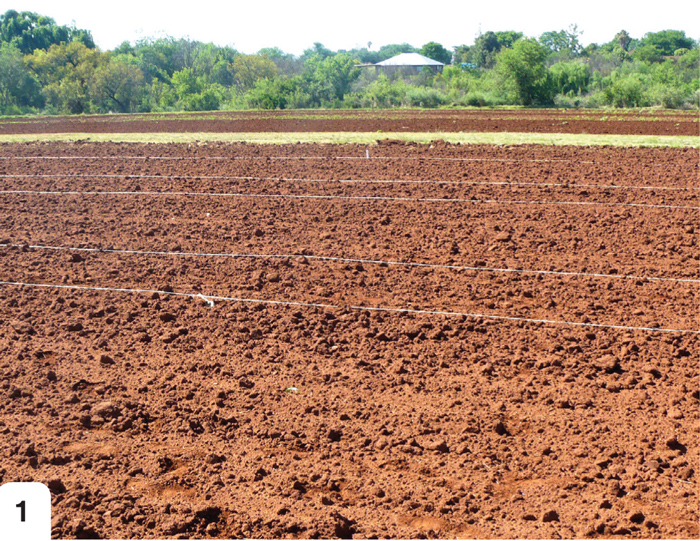
Damaged soil structure.
However, if a farmer chooses to cultivate these soils, the cultivation methods should be amended to improve its organic content. Soybeans can be cultivated in soil with a wide spectrum of clay content (10% to 45%).
Although soybeans perform relatively well in soils where the elements are not optimal, it is important to know what the optimal level for these elements are in the different soil types (see Table 2). The pH value of soil in which soybeans will be cultivated, should vary between a water-pH of 5,8 and 6,5.
If the application of lime is necessary, the magnesium content (Mg content) is often used as an indicator for which type of lime to use. If it is below 100 mg/kg, dolomitic lime must be used. If it is higher than 100 mg/kg or 0,6 x soil-calcium (Ca), calcitic lime should be used. Although soybeans are not overly sensitive to brackish soil, it is preferable that the natrium level should be below 50 mg/kg, with the resistance (R) between 2 000 ohm and 3 500 ohm, and the conductivity (EC) below 75 mS/m.
AGRICULTURAL PRACTICES
In the following sections, soil and other agricultural practices are discussed as they are applied throughout the season.
Fertilisation
As with many other crops, the fertilisation of soybeans depends on the withdrawal of elements by a specific crop. If the nutritional elements are thus at an optimal level, only the elements that were removed by the previous crop are replaced. Table 3 indicates the removal rates from the soil by soybeans.
Soybeans can be self-proficient in their nitrogen requirements through symbiosis with Rhizobium bacteria. As can be seen in Table 3, there is a need for especially K in the cultivation of soybeans. The fertilisation guidelines for P and K in soybeans are indicated in Table 4 and Table 5.
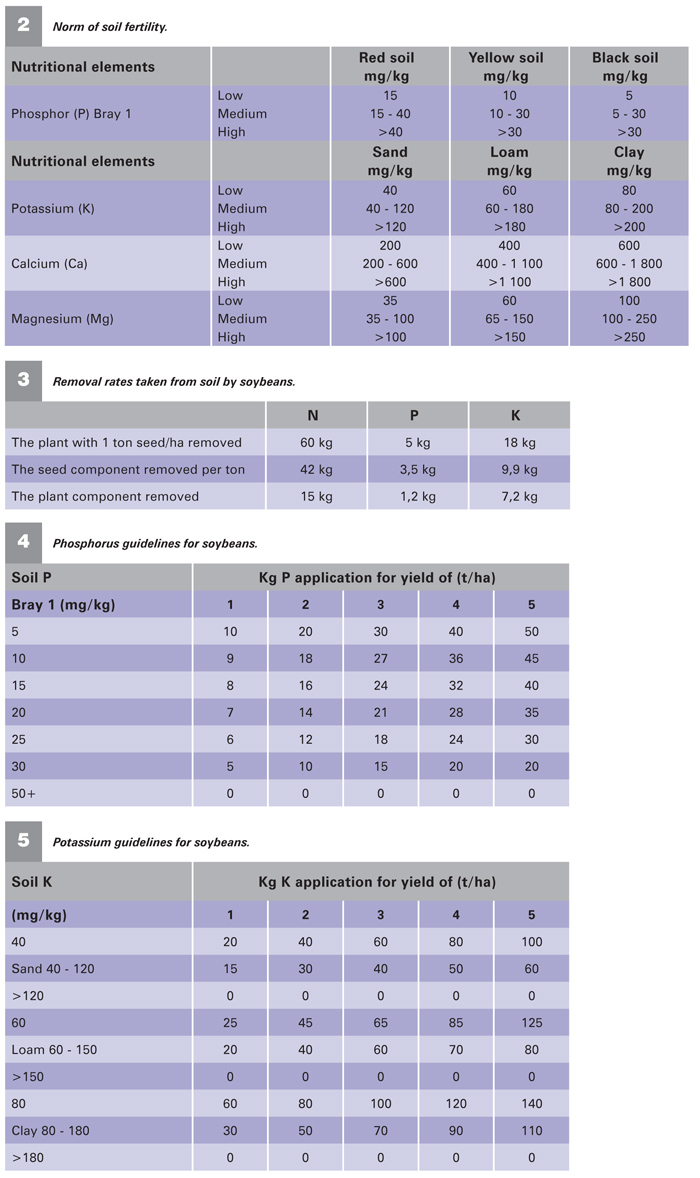
Most farmers spread fertiliser laterally and work it into the soil – or in the case of no-till, fertiliser is absorbed through rain and earthworms. Some farmers also use planters to ensure that the fertiliser is not put near the seed during planting. They usually plant using a mixture.
Where wind and sandy soils are a problem (as typically in the west), planting can be done with a complete NPK mixture, with the limitation that not more than 15 kg to 20 kg N is placed in the plant furrows. The mixture should also be kept away from the seed to prevent fertiliser burn. Photo 2 and Photo 3 indicate deficit symptoms of P and K.
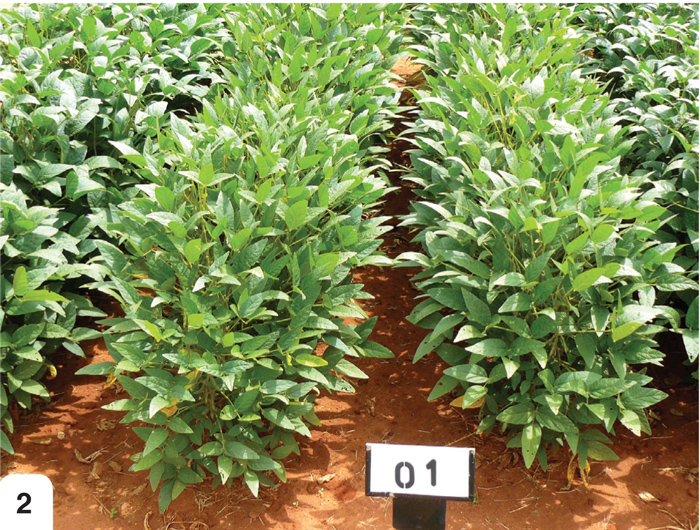
P-deficiency symptoms can be seen on the two rows in the middle.
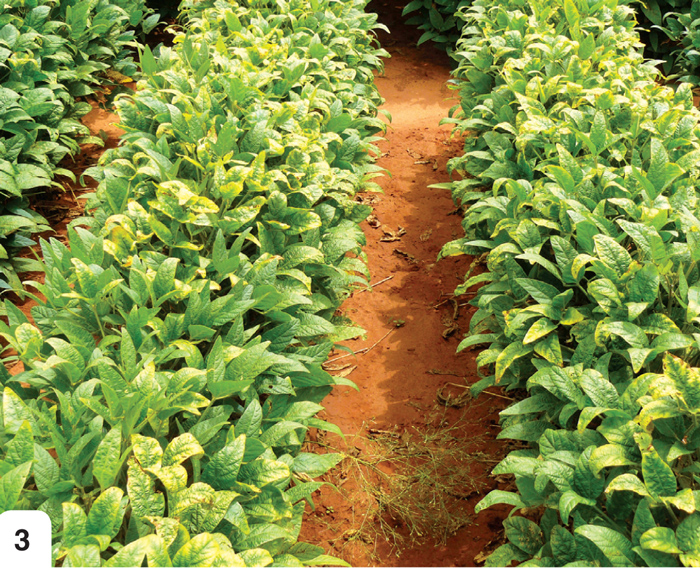
K deficiency symptoms are clearly visible on the two rows in the middle on this field.
Cultivars and maturity groups
All cultivars can be categorised in maturity groups, which indicate the number of days that it takes from the date of planting to reach maturity and be ready for harvesting. Maturity groups are divided into more groups, with 000 being the closest to the poles and 10 being the closest to the equator – put differently, a maturity group of 000 is planted in cooler areas, while a maturity group of 10 is planted in warm areas.
Maturity groups are furthermore divided in tenths within groups, for example 4,4 or 6,2. In South Africa, groups 4, 5 and 6 are most often planted and sometimes group 7. Groups 4 and 5 are planted in the cooler areas, groups 5 and 6 in the moderate climate areas, and groups 6 and 7 in the warm areas.
It is preferable that more than one maturity group is planted to mitigate the risks of drought, hail and diseases. It also prolongs the harvesting period. Certain soybean cultivars have a specific growth pattern. This means that it starts to bloom and finishes blooming within four to six weeks, and ends on the main stem with a raceme of pods.
The other type of growth pattern is non-specific. It is very sensitive to daylight and blooming will only start when the night-time is a certain length. If this type of soybean experiences drought conditions, it will stop growing and start producing pods. However, when there is moisture again, it will continue to grow and bloom until it reaches a certain number of days after planting (specific maturity groups).
Other characteristics to consider when choosing a cultivar, is the seed mass and structure (bushy or upright). For instance, a bushy structure has bigger potential because of more side stems. Also consider resistance to shattering late in the season and plant height – plants with a height of 76 cm to 80 cm are big enough and will be less prone to fall over than taller plants.
Currently more than 40 different cultivars are sold by various seed companies. It is important that seed is ordered before the season starts (as early as May), to ensure that farmers get the specific cultivar that they want.
Grafting of seed with Rhizobium bacteria
The soybean plant is totally dependent on nitrogen (N), which it gets from the Rhizobium buds on the roots. The plant provides carbohydrates and sugars to the Rhizobium in return for N. As the specific type of Rhizobium used in South Africa is not endemic to the country, it is important that the seed is properly grafted each season.
It is also important that when soybeans are planted for the first time, the seed is grafted in the plant furrows before and during planting. Keep in mind that Rhizobium are live organisms that can be killed by direct sunlight and the absence of oxygen in the soil, resulting from drowning.
If mistakes are made with the grafting, it will cost the farmer much more for something which could have been obtained for R60/ha to R90/ha. Currently there are seed companies that graft soybeans themselves and then sell it as such. Make sure you plant the seed before the expiration date of the vaccine.
Row widths and plant population
Soybeans are planted in row widths of 25 cm to 150 cm. However, the most row widths vary between 38 cm and 90 cm (Table 1). If the correct plant population is used, soybeans can be planted in any of the row widths mentioned above – just ensure the spacing of plants within the row is not closer than 4 cm and further than 8 cm. The idea behind this practice is that the farmer can use the same planter with which he plants maize.
It is important to remember that the plant population must be the same as what should be on the land at harvest time. A number of factors can contribute towards the ‘disappearance’ of plants throughout the season, such as a low germination percentage, insects, diseases and the oppression of some plants by others. Therefore, 15% to 20% more seed should be planted than the intended plant population at harvest time.

Planting date and planting process
The planting date is determined by the region (cool, moderate or warm). In the cooler regions, soybeans are sometimes planted as early as 10 October, but the optimum planting date is between 20 October and 20 November. In the moderate regions, planting takes place between 1 and 30 November, and in the warm regions it is between 15 November and 15 December.
The growth height of the cultivar also influences the planting date. If short growers are planted too early, it can be ready to harvest at the beginning of March, when quite a lot of rain can still fall and delay harvesting. However, do not plant it too late either, as it could then be ripe at the same time as the longer growers.
The best is to first start planting the longest growers to utilise the heat-units of the season optimally, then the shortest growers and thereafter the cultivars in-between according to the growth length. Take note that when reference is made to the longest and shortest group of cultivars, it refers to the region where it is planted.
In other words, in the cool regions, the longest group will be something like 5,8 or 6, while the shortest group will be something like 4,2 or 4,4. Likewise, in the warmer regions, a short grower will be indicated as 5,5 to 5,8 and a long grower as 6,8 to 7,0.
When replanting is necessary due to weak emergence or hail damage, a different approach is followed. If there was weak emergence or early hail, replanting can be done immediately, using the same maturity group that was planted originally. If late hail occurs and soybeans can still be planted, use a cultivar that is medium long, between 5 and 6. The idea here is that fast growers start to bloom two weeks after emergence – the plants end up being very small, with a low yield.
Soybeans are planted mainly with maize planters, of which the plates have been altered to accommodate the extremely high plant density. The opening up of the plant furrows – either with coulters or teeth – is used in specific conditions. In regions where wind damage can occur after planting, a deeper plant furrow is preferred to protect seedlings against the wind. The use of teeth is therefore a better option, and it can later be evened out with a land roller.
With coulters, there is basically only a cut in the soil, and the soil is then even for the harvesting process (Photo 4). Soybeans absorb 50% of their weight in moisture before they can germinate, and thus care must be taken not to plant too dry or too shallow. The planting depth can vary between 3 cm and 5 cm. If the chances are good that no rain is likely to fall between planting and emergence, planting can preferably be done a little deeper at 3,5 cm to 4,5 cm.
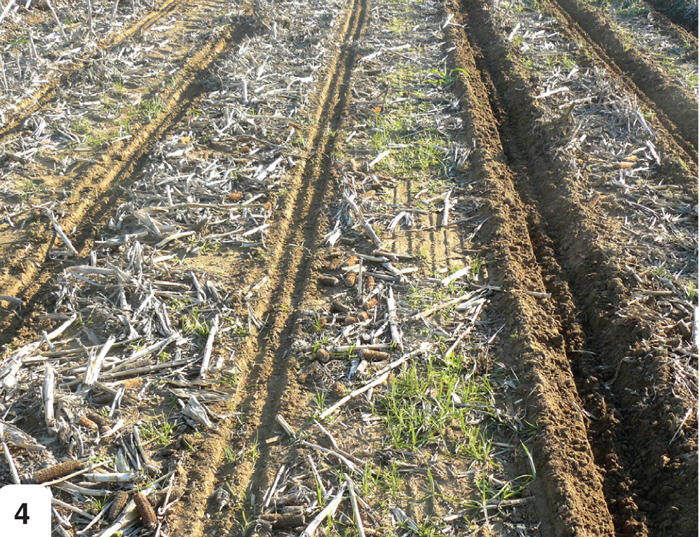
Opening of plant furrows: Left (coulter) and right (tine).
Weed control
These days, most soybean cultivars are resistant to glyphosate. This leads to farmers no longer effectively fighting weeds from emergence, because they can control it at a later stage. However, this practice is incorrect – over the last few seasons many farmers were caught off-guard by drenching rains in December, preventing them from entering the lands with spray equipment to control weeds. Soybeans that emerge together with weeds suffer damage from the start, and crop losses is a reality.
There are very good pre-emergence herbicides on the market that can be used to control grasses, broad leaf weeds and sedges. Farmers applying these herbicides usually do not even have to go back afterwards with glyphosate, which is economically a good practice.
Some weed species are becoming resistant to glyphosate, such as skraalhans, small-leaf spiderwort (wandelende Jood) and even green amarant (misbredie). Control with other herbicides is therefore extremely important, so that resistance does not get out of control.
Insects and diseases
Insects that can damage soybeans should be controlled timeously. Pests that should be controlled are bollworm, soybean looper, bontrokkie, all species of stink bugs, redspider, aphids and locusts.
Of the various diseases that occur on soybeans, two are especially important from an economic viewpoint: Soybean rust and Sclerotinia. Both these diseases are destructive, and although soybean rust can be effectively controlled with preventative spraying, there currently is not a product that is effective against Sclerotinia.
Attempts are made to eliminate Sclerotinia through the use of fast growers, as plants only get infected with it through lesions where flowers fall off. At this stage, the microclimate for the disease to start its lifecycle is not optimal and plants are thus not infected. Under irrigation, charcoal rot often causes problems.
Harvest
Soybean is harvested with a wheat harvesting table on a combine harvester. Several factors should be considered. It is important to set the speed of the feeding wheel to minimise the shattering of seed. The drum speed and concave must also be adjusted to limit the splitting of seeds, while also adjusting the air volume used to blow the crop residues away.
When harvesting, stop to assess the spillage of beans before it goes into the harvester and also the spillage behind the harvester. Make the necessary adjustments and then continue. In some cases, the spillage can be up to 150 kg/ha. Remember that silos receive soybeans at 12,5% moisture – therefore try to finish harvesting as soon as possible, as the moisture content can drop very quickly to 8%.
Publication: July 2023
Section: Pula/Imvula